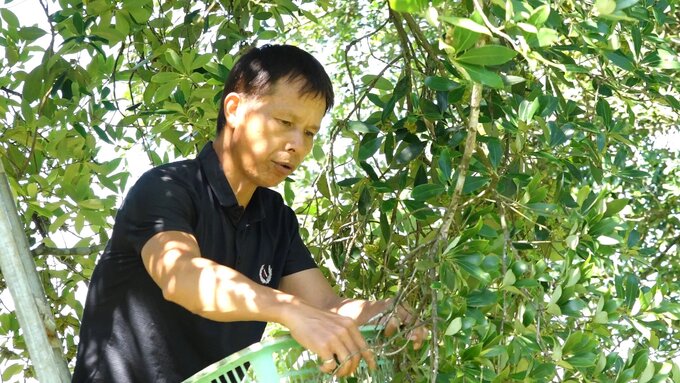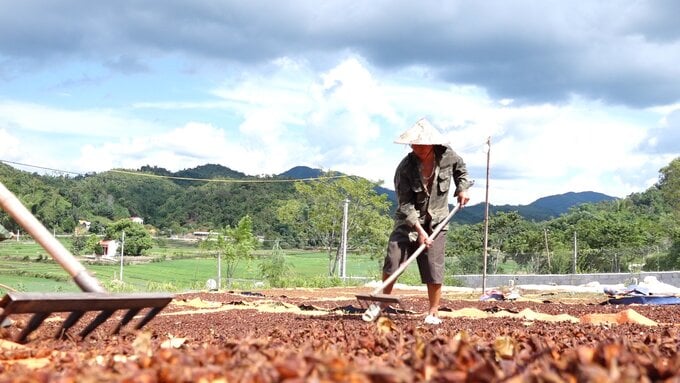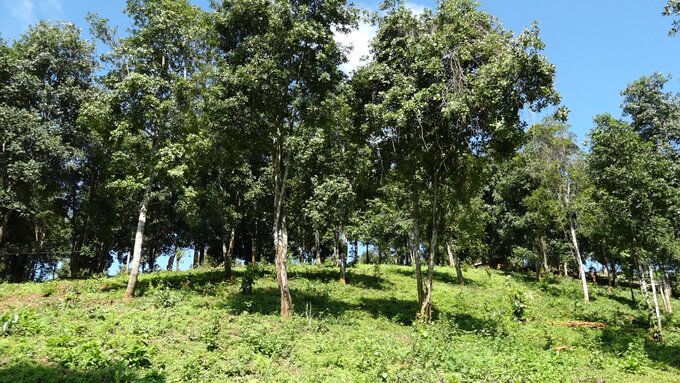November 25, 2025 | 21:21 GMT +7
November 25, 2025 | 21:21 GMT +7
Hotline: 0913.378.918
November 25, 2025 | 21:21 GMT +7
Hotline: 0913.378.918
Van Quan district possesses the largest anise growing area in Lang Son province. Among its over 14,800 ha, approximately 11,000 ha of anise are ready for harvest. The output can reach 30,000 tons of fresh anise per year. In this year's main crop, the district's star anise products have attained a high price, promising a harvest season that brings high economic value to the people of this land.
Having many years of experience in growing and taking care of anise, this year's harvest is considered a great joy to Sam Van Tu’s family. “We have 200 anise trees that are being harvested with an estimated output of more than 2 tons After the harvest, traders would come to our place to purchase at the current price of VND 45,000/kg of fresh star anise.”

Sam Van Tu (Binh Phuc commune, Van Quan district) collecting star anise. Photo: Nguyen Thanh.
Also according to Sam Van Tu, over the years star anise has become the main economic product of the people in Van Quan. Star anise’s price is relatively high in recent times, so many households have developed and expanded new anise growing areas in the organic direction, aiming to meet the consumption demands of domestic and foreign markets.
Export markets mainly include China, India, and Thailand with prices ranging from VND 150,000 to VND 250,000 for 1 kg of dried anise. Thanks to the current situation, households gaining a profit of VND 200 – 300 million/crop is no longer a rare tale in Van Quan, and side jobs like purchasing fresh anise for drying and exporting are also thriving.
Vi Thi Mai (Diem He commune, Van Quan district), a veteran in purchasing and selling dried anise, assessed that this year’s crop experienced a slight decline in output, but instead the price was fairly higher. “If the price was VND 30,000 – 35,000/kg last year, now it has increased to VND 40,000 – 45,000/kg. But of course, price still depends on the market outside.”

Star anise is dried after harvesting. Photo: Trang Anh.
Van Quan district has mobilized all resources to develop anise production, supported seedlings, fertilizer materials for growing models and targeted sustainable anise forest development programs, and boosted trade promotion to develop consumption markets and stabilize output for anise products. “We also promote attracting businesses to build processing plants, have cooperation programs to create more products from anise, export to larger markets, create sustainability,” said Head of Van Quan District Agriculture and Rural Development Office Nong Van Tung.
According to statistics from the World Spice Association, Vietnam ranks second after China in terms of star anise production, in which Lang Son is currently the province with the largest anise area and production in the country.
The total area of star anise in Lang Son has reached nearly 34,000 ha up until the present date. Data from 2021 shows that the province's total dried anise output was 16,066 tons, bringing in nearly VND 1,500 billion in revenue.
Aiming toward sustainable development of star anise, Lang Son is currently encouraging and supporting people to grow star anise according to organic standards through investment projects in Chi Lang, Binh Gia and Van Quan districts. Organic cultivation of anise is showing positive signs as the plants grow well, are less susceptible to pests and diseases, and increase by 15-20% in terms of yield.

Anise is grown organically to increase yield and quality. Photo: Trang Anh.
“People in localities are trained in organic farming and ensuring their health because they do not use toxic substances in the cultivation process. The organic planting models help to enhance the porosity and fertility of the soil, thus improving the ecology of anise forests. Biodiversity also contributes to plant growth, gradually reducing the rate of pests and diseases. Meeting the export requirements of major markets in the world means more attraction to businesses investing in production consumption, especially in the field of herb production,” said Deputy Director of Lang Son Department of Agriculture and Rural Development Vu Van Thinh.
However, organic agricultural production has the difficulty that the effect is not quick to be seen and it calls for the perseverance of producers. There also requires a close linkage between businesses and growers to secure the product consumption market.
The production of anise according to organic standards is an inevitable trend as it strengthens the accessibility of Lang Son anise products to foreign markets that are meticulous but full of potential at the same time, step by step affirming Lang Son specialties’ brand name worldwide.
Translated by Samuel Pham
/2025/11/24/3536-2-112800_176.jpg)
(VAN) Dong Nai now has tens of thousands of hectares of forests certified for sustainable management, and this area will continue to be expanded in the coming period.

(VAN) Vinh Ha hamlet (Dai Xuyen commune, Hanoi) is shifting away from small-scale farming as households adopt bioscurity into their breeder chicken models.

(VAN) Heavy rains make aquatic species more vulnerable to disease. Proactive water management and high-tech systems help farmers prevent outbreaks and protect yields.

(VAN) Greenhouses are shifting production mindsets in Binh Lu commune, enabling farmers to ‘weather the sun and rain’ and secure stable vegetable harvests throughout the year.

(VAN) Green transition is crucial for the Mekong Delta amid climate change and stricter standards, offering a path toward sustainability.

(VAN) Dong Thap promotes agricultural restructuring, forms large specialized farming zones, raises the value of agricultural products and develops toward ecological and high-tech directions.
/2025/11/22/4018-4-213342_747.jpg)
(VAN) The Mekong Delta Agricultural Experts Club has attracted 143 experts and researchers to participate in providing consultancy and contributing initiatives to the development of one million hectares of high-quality rice.